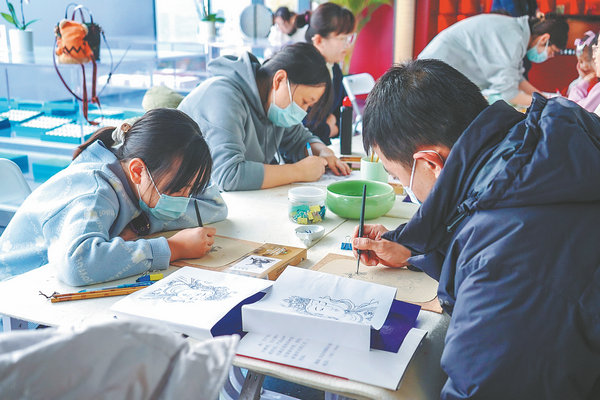

In recent years, the rapid development of a high-tech industry featuring technology services, digital creativity and new-generation information in the area has given the Shijingshan district government more confidence in the digital display of the frescoes.
The Fahai Temple Mural Art Center was officially opened to public on Jan 18 last year, with Liu, who has seen numerous frescoes and many architectural and artistic treasures abroad, becoming the curator of the center.
As curator, he completed the planning of the four-hour digital content for center's exhibition.
At the exhibition of Fahai Temple Mural Art Center, the original scale of mural paintings is presented with a 4K HD display. Each one of the 77 figures is portrayed with immaculate attention to detail by 3D modeling at the pixel-level.
The facial details of Water-moon Avalokitesvara, one of the most representative figures on the frescoes of Fahai Temple, are hard to make out in dim conditions. However, after 3D modeling, the figure's face, which is over 3 meters high, can be seen clearly on the 4K HD screen at the Mural Hall in the basement of the art center.
"Through technological means, we magnify and zoom in to show specific details and introduce the content of the frescoes item by item, offering the audience ample time to understand the frescoes," Liu explained.
"We have also introduced nearly a hundred domestic and foreign cultural relics and cave data for comparison with the Fahai Temple frescoes, enabling the audience to gain a clearer and more intuitive understanding of the origins and influence of frescoes here."
With the completion of the art center, visitors can enjoy a fun and immersive experience that illuminates the life and times in which the frescoes were created and rediscovered.
The art center invited students from a middle school in Beijing to celebrate the Spring Festival in the center. They performed dances and learned about the mural culture.
"Whenever I see a visitor lingering in front of a screen in the art center, watching the content for a long time, I feel particularly happy, and I believe everything is meaningful," Liu says.
Liu's story is also expressive. He used to be an IT programmer and reached a high position in an IT company. His love for ancient architecture and cultural relics, especially frescoes, led him to visit almost all the grotto temples in China. In time, he left his previous career and embarked on a brand-new path in history and culture.
He said the colored sculptures in the hall of Xiaoxitian Temple in Xixian county in Shanxi province had a tremendous impact on him when he first visited there in 2014.
"I never expected that such a remote place, such an unknown cultural relic, could be so magnificent,"Liu says.
Since 2016, he has been a volunteer guide at several museums in Beijing, attracting numerous fans with his expertise and erudition. At the end of 2021, the Shijingshan district approached Liu and asked him to take on the curation work for the digital exhibition of Fahai Temple.
Later on, he became the curator of the center, gradually realizing his dream fueled by his love for ancient relics.